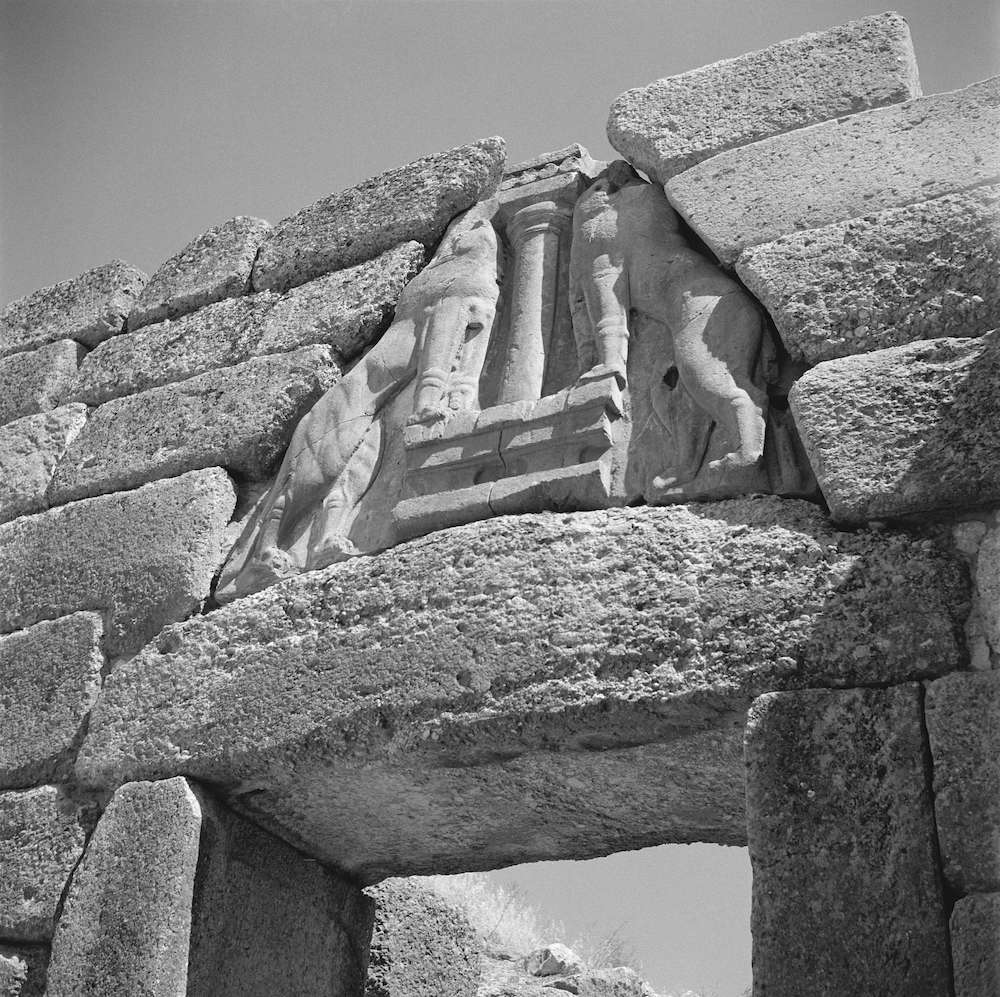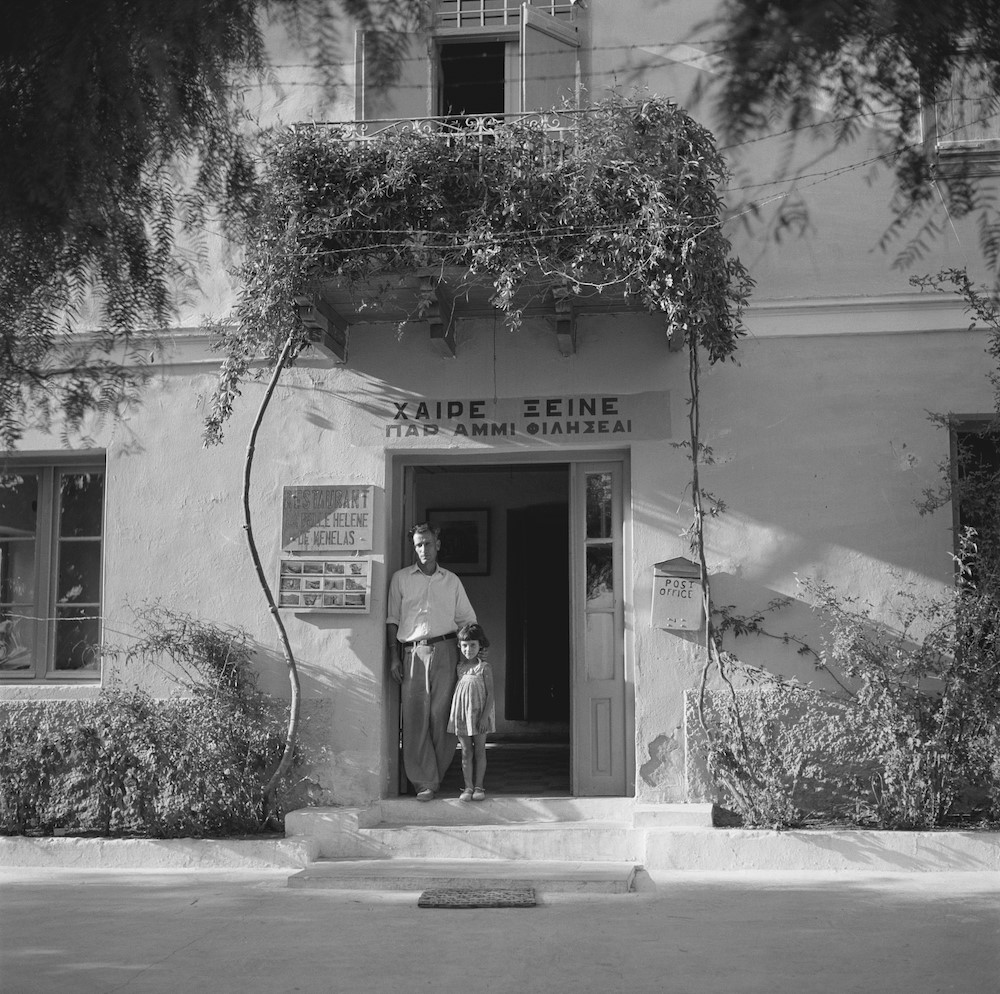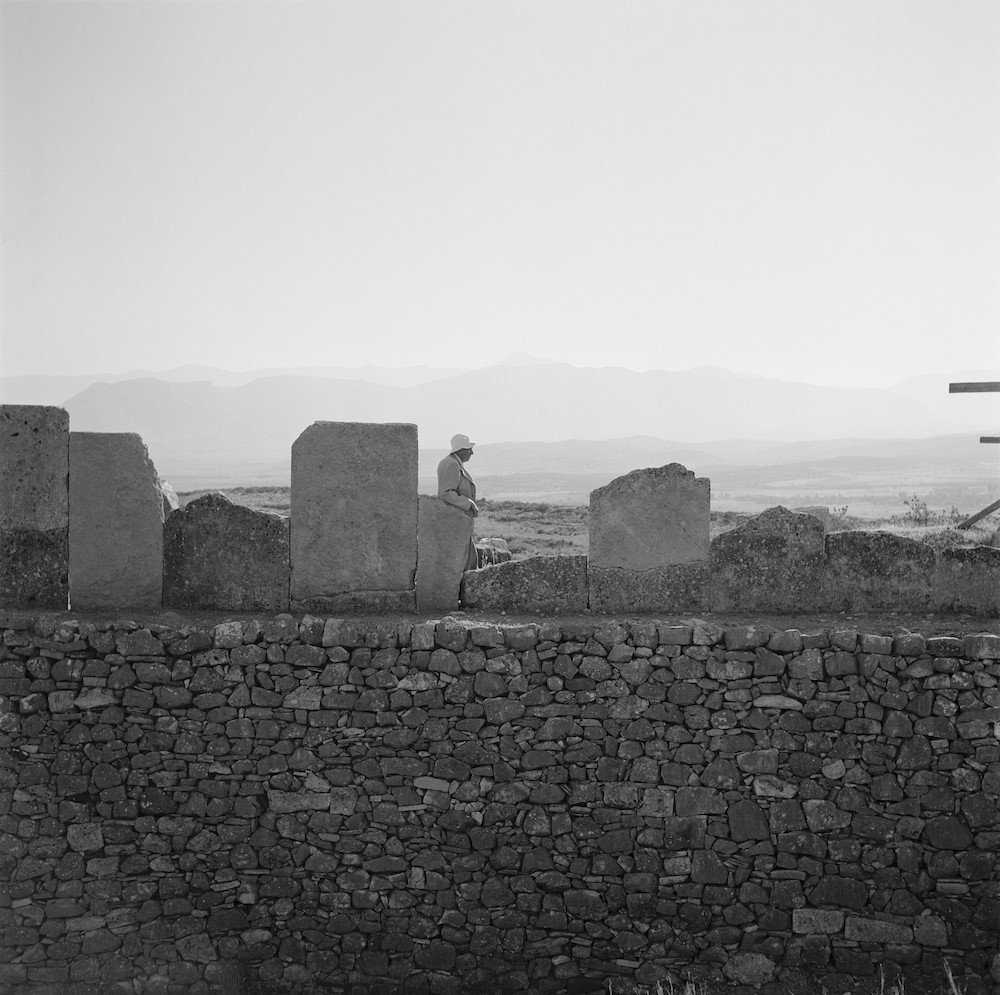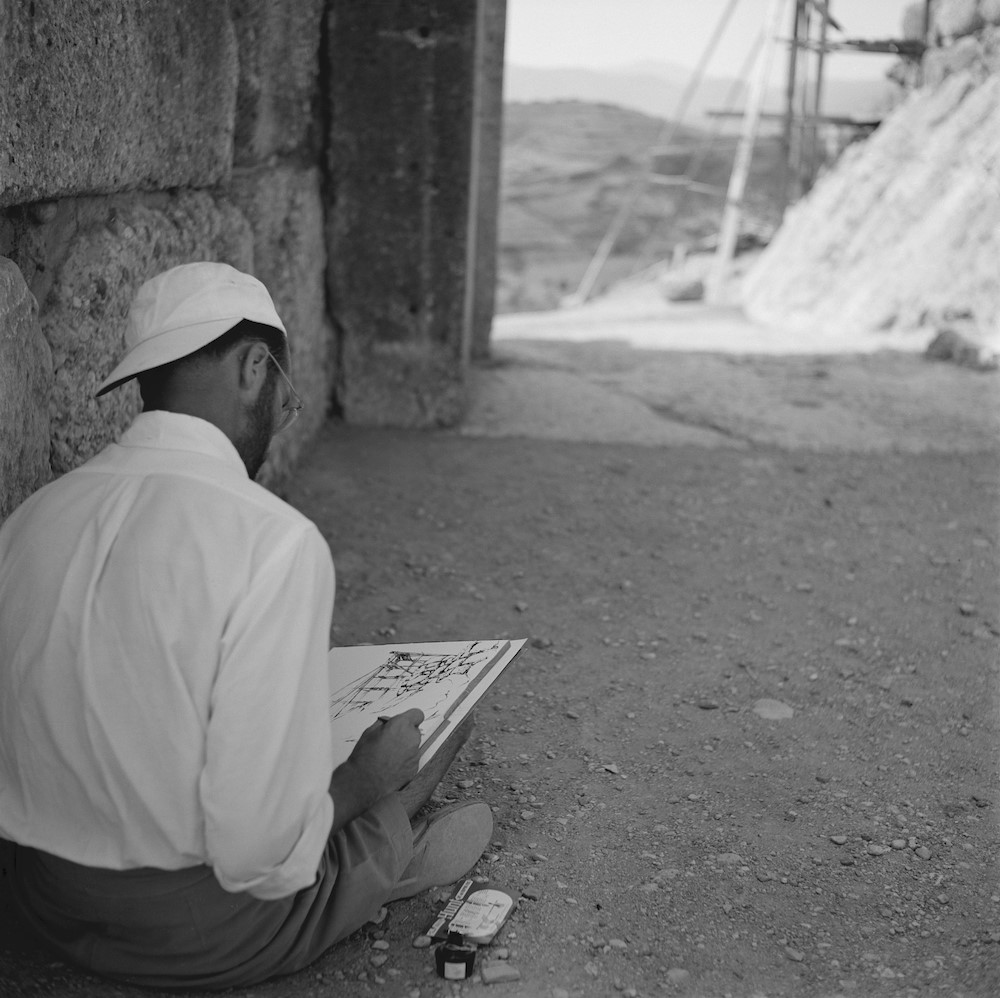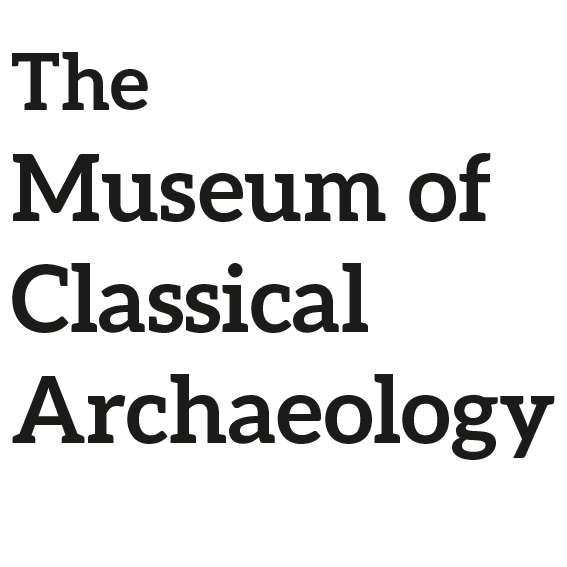
Mycenae: From Myth to History
An exhibition of photographs by Robert McCabe
28 September - 10 December 2021
In the summer of 1955, a young Robert McCabe was given a simple assignment by Professor Alan John Banyard Wace: to create a visual record of Mycenae with his Rolleiflex camera and Plus-X film.
McCabe took some 200 photographs that year, a small number perhaps by modern digital standards but a sizeable and comprehensive record nonetheless. This exhibition features around fifty of those photographs, capturing a black and white archive of the site and its place in the broader landscape – a landscape peopled in McCabe's photographs by both archaeologists and locals alike, whose interactions and stories are remembered in the captions.
The lion relief over the main gateway at Mycenae. Copyright: Robert McCabe.
Mycenae holds a special place in both Greek myth and Greek history. The stories of its people and its kings are woven through ancient storytelling, from Homer's Iliad to the tragedies of Aeschlyus and Sophocles, and beyond. Those stories tell of a distant past, of a city ruled by a family riven with discord and treachery: Agamemnon, who led the Greek forces against the city of Troy in defence of his brother Menelaus' honour, only to be killed upon his return home by his own wife, Clytemnestra, and her lover.
The archaeological site itself is located in the north-east Peloponnese in Greece. Mycenae was a powerful Bronze Age centre of production and administration, with dominance over the surrounding territories on the southern Greek mainland and islands, including Crete.
The remains of a palace complex, with temples, storerooms, craft workshops and housing surrounded by imposing fortified walls, are testament to a flourishing city. Beyond the citadel, tombs and roads linked the centre to its locality and beyond, since the city controlled trade routes over both sea and land.
In 1999, UNESCO deemed Mycenae to be a world heritage site, highlighting the impact the site had and continues to have on European art and literature for more than three millennia. Last year marked the centenery of the British excavations at Mycenae, under the directorship of Alan Wace.
To buy
Copies of Mycenae: From Myth to History, by Athina Cacouri and Robert McCabe, with a commentaries by Lisa Wace French, are available for purchase in the Museum. £28.99.
Mint-edition copies of Greece Untrodden, by Alan Wace, published in 1964. £15. Please contact us at museum@classics.cam.ac.uk for a price including post and packaging.
- Purchase Mycenae: From Myth to History online
- Purchase limited edition photographic prints by Robert McCabe online
Agamemnon Dassis with his daughter Panagoula (Loula) at the door of the Belle Helene inn. Copyright: Robert McCabe.
About Robert McCabe
Robert McCabe was born in Chicago in 1934 and grew up in Rye, New York. His father worked for a picture newspaper in New York City, and as result of his father's gift of a Kodak Baby Brownie in 1939, McCabe started taking photographs when he was five.
His first photographs of Europe were the result of a trip in 1954 to France, Italy, and Greece. He returned to Greece in 1955 and 1957, and photographed the Cyclades for National Geographic. His black and white photographs were first exhibited in 1954 and 1955 at Firestone Library at Princeton University, and in a travelling exhibition which ensued. Since then, he has exhibited his work in London, Paris, Brussells, in many locations in Greece including several exhibitions in Athens, as well as in Patmos, Santorini, Thessaloniki, Monodendri, Corfu and Poros.
He has also exhibited in the United States in New York City, Boston, and Jackson Hole, WY. His published books cover subjects and locations in Greece, France, Italy, New York City, New England, Havana, China, and Antarctica.
- Visit Robert McCabe's website
Remembering Alan Wace
Alan John Bayard Wace (13 July 1879 – 9 November 1957) was one of the leading archaeologists of early Greece in the 20th century. He features as a strong and noticeable presence in McCabe's photographic landscape, a tall figure framed by the archaeological features he studied and excavated. Permission to excavate Mycenae was granted to Wace, as director of the British School at Athens (1913-1923), personally by Christos Tsountas on behalf of the Archaeological Society of Athens in 1920. The dig began on 23 April 1920.
Wace directed the excavations at Mycenae until 1955, the year he met Robert McCabe. In the intervening years, he had strong links with Cambridge. As a student, he had read the classical tripos at Pembroke College, and he returned to become the Laurence Professor of Classical Archaeology, a position he held from 1934-1944. Today, both the Mycenae Excavation and Publication Archive and the Alan John Bayard Wace Professional Archive are held at the Faculty of Classics Archive and have been partially digitised.
- Read more about Digital Mycenae, celebrating 100 years since Wace first broke ground at Mycenae.
Remembering Lisa (Elizabeth) French
Elizabeth Bayard French (née Wace, 19 January 1931 – 10 June 2021) was the daughter of Alan and Helen Wace – and she carved out a ground-breaking career as an archaeologist. Following in her father's footsteps as a world-renowned expert on Mycenaean figurines, she would also become the first female director of the British School at Athens from 1989-1994.
French first joined Wace's excavations at Mycenae in 1939, when she was aged 8. She went on to excavate there alongside her father from 1950-1957, starting while she was still an undergraduate reading Classics at Newnham College, Cambridge. Following his death, she continued to excavate at Mycenae alongside Lord William Taylour and George Mylonas until 1967. She was joint editor of the Well Built Mycenae series of books, and in 2013 she donated the archives of the excavations at Mycenae, as well as her own professional archive, to the Faculty of Classics in Cambridge.
Alan Wace looking out across the Citadel Wall. Copyright: Robert McCabe.
Remembering with Robert McCabe
Here, in his own words, Robert McCabe remembers his friendship with the Waces in 1955:
I had made my first trip to Greece in 1954 and had taken a few photographs of Mycenae. In the spring of 1955 some of them were displayed at Princeton’s Firestone Library in connection with an exhibition about the decipherment of Linear B. Prof. Wace came over from the Institute for Advanced Study for a look. After examining the photos and noting a misspelling in our attempt to write “Mycenae” in Linear B, he asked if I would come to Mycenae that summer and take photographs.
There was a bonus to Wace’s assignment. I learned about it on my arrival at the British School. Professor and Mrs. Wace invited me to accompany them on a tour of the Peloponnesus. I considered it an enormous honor for someone who had just completed their junior year, and had been rejected by the Classics Department because I knew only Latin and not Ancient Greek.
At Pylos, when Blegen heard I had camera he grew fearful that it could lead to an unintended leak to the press about the bathtub. So my camera sadly was barred from the site. But it did give me an opportunity to photograph and get to know Piet de Jong working at the Chora museum, and also to take a long hike on Sphakteria.
My assignment led to some lifelong friendships. On the road trip while the Waces were having a siesta in Nauplion I decided to rent a motorbike and visit Asine and try to understand why Homer had mentioned it in the catalogue of ships. On the way back the front wheel of motorbike flew off and I landed hard on the asphalt. A truck came along and lifted me and the remains of the bike into the back. The Waces were at the hotel entrance ready to leave when I was deposited. Mrs Wace took one horrified look at the blood and said we must get him to the Americans at Lerna for first aid. So we rushed there around the Gulf and the first person in attendance was Lloyd Cotsen. We became close friends and I was later one of Lloyd’s successors as president of the Trustees of the American School.
At Mycenae working that summer were both Charles Williams and Lisa Wace. Charles became chairman of the American School board. (Today as I write this he is still at work in Corinth on two important projects.) Lisa, along with Athina Cacouri, were later to become collaborators on our book about Mycenae. One morning at an early breakfast in a beehive tomb with Charles and Lisa and others, Mrs Wace watched me carefully for some seconds as I fumbled trying to eat a fig. With what can only be described as a touch of disdain she turned to Charles and said “Please teach Robert how to eat a fig.” For 65 years each time I eat a fig Charles’ tutorial comes back.
There is one memory that haunts me still. During the car trip in the Peloponnesus Wace spoke almost continuously about the history of the sites and the landscapes we drove through. It was as though he knew every stone. Once we stopped in the Taygetos at a small road side taverna. Wace started recounting the history of the area. A small crowd of customers and employees gathered to listen. I didn’t take notes and I didn’t have a recorder. But ever since then as I have become friends with extraordinary people in the archaeological community I think to myself how sad it is to lose so much of this knowledge and these insights as each generation leaves. So Bruce Hartzler, the technical genius who develops archaeological software, and I are exploring solutions to this knowledge leak in Greek archaeology and history.
Charles Williams (excavation architect 1955) sketching, sitting in the shade of the Lion Gate. Copyright: Robert McCabe.
Acknowledgements
The Museum would like to thank Robert McCabe for kind permission to reproduce his images and tireless support for the exhibition, despite the delays caused by the pandemic.
Robert McCabe would like to thank museum staff: Dr Yannis Galanakis and Dr Susanne Turner for curatorial support, and Sade Ojelade for graphic design. The captions were written by Lisa Wace French for the publication Mycenae: From Myth to HIstory, the driving force behind which was Athina Cacouri, without whom the book could not have been written. Scans, editing and printing were undertaken by George and Sophie Marinos at Idolo Lab, and mounting by Constantinos Karasaviddis. Oversized images were prepared and printed by AVMG, Cambridge.
Transportation was kindly supported and undertaken by Aegean Airlines.


